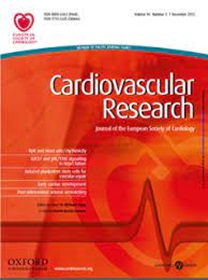CircRNAs increase during vascular cell differentiation and are biomarkers for vascular disease
IF 10.2
1区 医学
Q1 CARDIAC & CARDIOVASCULAR SYSTEMS
引用次数: 0
Abstract
Aims The role of circular RNAs (circRNAs) and their regulation in health and disease are poorly understood. Here, we systematically investigated the temporally resolved transcriptomic expression of circRNAs during differentiation of human induced pluripotent stem cells (iPSC) into vascular endothelial cells (EC) and smooth muscle cells (SMC) and explored their potential as biomarkers for human vascular disease. Methods and Results Using high-throughput RNA sequencing and a de novo circRNA detection pipeline, we quantified the daily levels of 31,369 circRNAs in a two-week differentiation trajectory from human stem cells to proliferating mesoderm progenitors to quiescent, differentiated EC and SMC. We detected a significant global increase in RNA circularization, with 397 and 214 circRNAs upregulated > 2 fold (adjusted P < 0.05) in mature EC and SMC, compared with undifferentiated progenitor cells. This global increase in circRNAs was associated with upregulation of host genes and their promoters and a parallel downregulation of splicing factors. Underlying this switch, the proliferation-regulating transcription factor MYC decreased as vascular cells matured, and inhibition of MYC led to downregulation of splicing factors such as SRSF1 and SRSF2 and changes in vascular circRNA levels. Examining the identified circRNAs in arterial tissue samples and in peripheral blood mononuclear cells (PBMC) from patients, we found that circRNA levels decreased in atherosclerotic disease, in contrast to their increase during iPSC maturation into EC and SMC. Using machine learning, we determined that a set of circRNAs derived from COL4A1, COL4A2, HSPG2, and YPEL2 discriminated atherosclerotic from healthy tissue with an AUC of 0.79. CircRNAs from HSPG2 and YPEL2 in blood PBMC samples detected atherosclerosis with an AUC of 0.73. Conclusions Time-resolved transcriptional profiling of linear and circular RNA species revealed that circRNAs provide granular molecular information for disease profiling. The identified circRNAs may serve as blood biomarkers for atherosclerotic vascular disease.求助全文
约1分钟内获得全文
求助全文
来源期刊

Cardiovascular Research
医学-心血管系统
CiteScore
21.50
自引率
3.70%
发文量
547
审稿时长
1 months
期刊介绍:
Cardiovascular Research
Journal Overview:
International journal of the European Society of Cardiology
Focuses on basic and translational research in cardiology and cardiovascular biology
Aims to enhance insight into cardiovascular disease mechanisms and innovation prospects
Submission Criteria:
Welcomes papers covering molecular, sub-cellular, cellular, organ, and organism levels
Accepts clinical proof-of-concept and translational studies
Manuscripts expected to provide significant contribution to cardiovascular biology and diseases
 求助内容:
求助内容: 应助结果提醒方式:
应助结果提醒方式:


